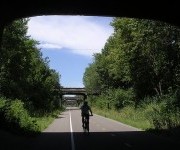The Midtown Greenway in Minneapolis.Photo: livewombaIf you’ve never been to Minneapolis, you’re missing out: It’s populated by unrelentingly friendly folk, oodles of lakes surrounded by city parks, and a bike network on its way to becoming second-to-none. Just last month, Bicycling magazine named it the top city for bicycling, and a few months before, the League of American Bicyclists gave it a gold medal. These days, bikes are a big deal in the bigger of the Twin Cities.
These accolades aren’t exactly unexpected: Minneapolis has put a lot of effort into bolstering its bike-friendliness. Money from the U.S. Department of Transportation’s Nonmotorized Transportation Pilot Program has given Minneapolis — along with Columbia, Mo., Marin County, Calif., and Sheboygan County, Wis. — a total of $25 million to improve biking and walking infrastructure. But the city deserves much credit for its laser-like focus on improving biking conditions.
We can trace much of the city’s bike renaissance to the Midtown Greenway, a 5.5-mile former railroad opened in 2000 that has since has become a non-automotive superhighway. Cyclists and pedestrians can hop on and off at various points with ease, and the striking Martin Olav Sabo Bridge sends cyclists over busy Hiawatha Avenue. The path even has its own dedicated bike shop complete with bike parking, water, bathrooms, and showers for commuters. Basically, it’s a cyclist’s dream.
Beyond the Greenway, Minneapolis has followed a 10-step program of sorts to guide its bike-friendly improvements. Many steps — like dedicated bike lanes, lanes buffered from traffic, and plenty of bike parking — are obvious choices, but others draw on ideas culled from around the country.
One of my favorites is their adoption of bicycle boulevards (which I remember fondly from my time in Berkeley). Bike boulevards route bicycle traffic down nearly deserted side streets, where car traffic is kept low by including speed humps and “diverters” that block cars but allow bikes to pass through. At busy intersections, bikes even get special sensors beneath the pavement to change traffic signals. They’re a great way to get across town in a hurry.
On busier roads where there’s no space for dedicated bike lanes, Minneapolis has painted “advisory” bike lanes. These lanes are demarcated by dashed lines and run on both sides of the street. Since this takes away space from existing car lanes, the city simply removed the old center line. This gives bikes visual priority on the street, and the narrowed center lane slows car traffic. Where possible, the city has reduced the number of regular lanes on some roads to widen bike lanes.
With all these pieces in place, Minneapolis’ seems well-poised to overtake Portland as the country’s top bike city. Though Portland can still boast that 5.8 percent of its commuting trips happen on a bike, Minneapolis is catching up with an impressive 3.8-percent bike commuter rate. The improvements also encourage more errands by bike, and to lure the uncertain, bike lanes and paths also tie into the city’s extensive park system. It’s taken a lot of effort to get to this point (including lots of political support from the mayor’s office), but Minneapolis is getting ever closer to becoming a two-wheeled paradise.



